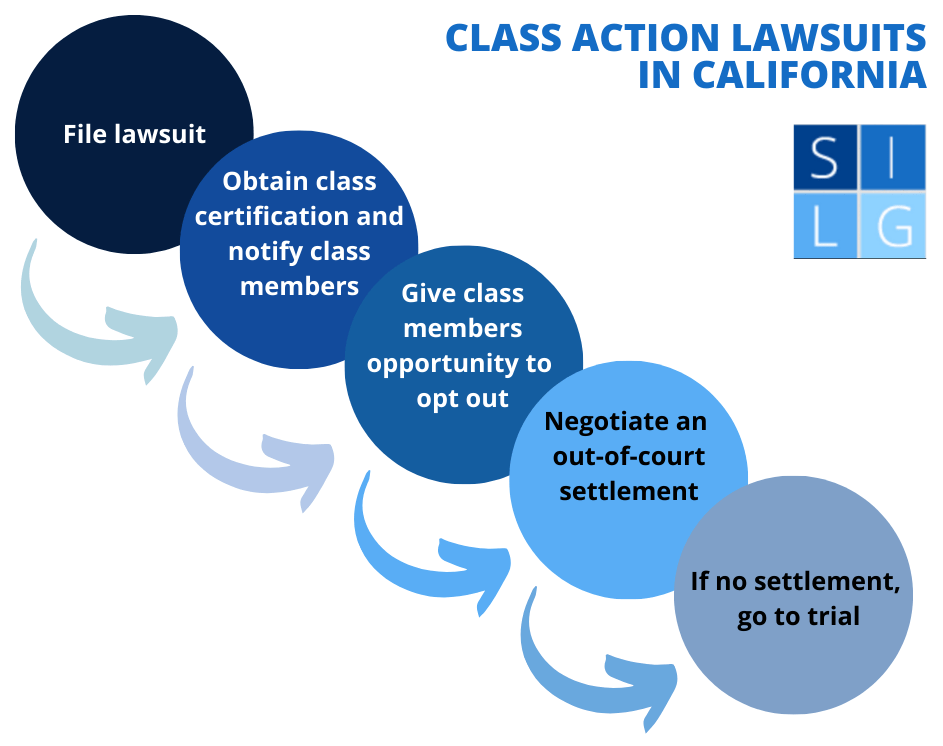In California, class action lawsuits are a procedural tool allowing multiple people to file a lawsuit jointly when they all suffered the same type of harm at the hands of the same defendant. Named plaintiffs bring legal claims for the entire class, and other impacted people can join as class members.
Class actions are often brought against companies that:
- sell defective products,
- create an environmental hazard, or
- commit wage and hour violations against its workers.
Requirements to form a class action
Courts “certify” proposed class actions only when they meet these four thresholds:
- Commonality: There must be major common legal and factual questions shared by all class members.
- Typicality: The claims of the main class representatives must be typical and aligned with the class.
- Adequacy: The class representatives must fairly and adequately protect class interests, and they cannot have conflicting interests or motivations compared to other members.
- Superiority: A class action would provide substantial benefits to the litigants and the courts, and it would be better at resolving the issue than other methods.
Once a class action is formed, any ruling applies to all individuals fitting the class definition.
Benefits of class actions
Class actions achieve multiple public policy goals:
- They provide legal recourse even when individual damages are small.
- They can modify corporate behavior.
- Settlements compensate more victims efficiently through a single case.
However, participating in a class action may require you to relinquish rights to sue independently.

Below, our California personal injury lawyers will answer these faqs:
- 1. What are class actions?
- 2. How do I start a class action lawsuit?
- 3. What criteria does a California court use in certifying a class?
- 4. What is the procedure?
- 5. Can I “opt out”?
- 6. Does everyone get the same amount of money in a class action lawsuit?
- 7. How is multi-district litigation different?
- Additional resources
1. What is a class action lawsuit in California?
A class action in California is a lawsuit that resolves a common issue of liability and/or damages affecting a large group of people. California Code of Civil Procedure § 382 provides:
“[W]hen the question is one of a common or general interest, of many persons, or when the parties are numerous, and it is impracticable to bring them all before the court, one or more may sue or defend for the benefit of all.”
Class actions are beneficial for cases where each class member is seeking a relatively small amount of money (like after being overcharged on a cable bill or other utility bill or being victims of a scam). Bringing an individual lawsuit would not be worth the expense, but bringing a class action would.

Similar injury victims with similar grievances may be able to band together in a collective action against the same business or person who harmed them.
2. How do I start a class action lawsuit?
You can initiate a class action in California. The first step is to file a lawsuit and move for certification.
The court then decides whether the proposed new class action claim meets the requirements for certification. At this point, the judge does not consider the underlying merits of the case. The judge only determines whether the claims should be tried under CCP 382.1
3. What criteria does a California court use in certifying a class?
To get a certification in California, you must establish that there is “an ascertainable class” and a “well-defined community of interest among [] members.”2
“Community of interest” is determined by three factors:
- Predominant common questions of law or fact;
- Class representatives with claims or defenses typical of all the members of the proposed class; and
- Representatives who can adequately represent all the members of the class.
You must also establish that resolving the claims in this type of lawsuit would “provide substantial benefits” to both the courts and the litigants.3 This involves showing that this type of lawsuit is superior to alternative methods of resolving the dispute(s), including individual litigation.4
4. What is the procedure?
Once the class is certified, the case moves forward as a lawsuit.
The court will notify potential members of the case by mailing them legal notice of the claim. The notice will explain what the class action case is about and the rights of each member.
If the class action litigation is eventually resolved in your favor (either by trial or settlement) the court will notify members how to make a claim for relief. In such a case, the defendant will usually be ordered to pay your fees and costs – including:
- attorneys’ fees, and
- court costs.5
5. Can I “opt out”?
You usually have the right to “opt out” of class actions or proposed settlements in California. The opt-out procedure will be explained in the legal notice sent by the court.
By opting out, you retain the right to file an individual lawsuit. If you do nothing, you will be bound by any settlement or decision in the lawsuit.
6. Does everyone get the same amount of money in a class action lawsuit?
Only if everyone in the class suffered identical damages. Usually there are some class members who sustained mild injuries and others who endured major losses. So once a class action finally settles, the money should be divided among the class members in proportion to your individual losses.
7. How is multi-district litigation different?
Both class actions and multi-district litigations (MDLs) involve groups of plaintiffs with similar injuries joining a common lawsuit. Though with MDLs, cases remain individual and separate rather than merging into one class.
This way, MDLs merely coordinate pre-trial proceedings across cases for increased efficiency while allowing each case to have a different outcome. This is in contrast to class actions, where members are bound together throughout with uniform settlements or verdicts applying equally to everyone who does not opt out of the class.
Another difference is that class actions automatically include anyone who meets the class definition, and members are given the option to opt out. With MDLs, plaintiffs need to affirmatively join the MDL through court filings.
Additional resources
For more in-depth information, refer to these scholarly articles:
- The Class Action Counterreformation – Stanford Law Review.
- Is the Class Action Really Dead – Is That Good or Bad for Class Members – Emory Law Journal.
- Effective Use of Class Action Procedures in California Toxic Tort Litigation – Hastings West-Northwest Journal of Environmental Law and Policy.
- Precertification Settlement of Class Actions: Will California Follow the Federal Lead – Hastings Law Journal.
- Daar v. Yellow Cab Co.: The Advent of the Consumer Class Action in California – University of San Francisco Law Review.
Legal references:
- Lindner vs. Thrifty Oil (2000) 23 Cal.4th 429; see, for example, Evenskaas v. Cal. Transit (Court of Appeal of California, Second Appellate District, Division Seven, 2022) 2022 Cal. App. LEXIS 622; Ferra v. Loews Hollywood Hotel, (California Supreme Court, 2021), 11 Cal.5th 858; Falk v. Children’s Hospital Los Angeles ( See also CACI 115 – Class Action Defined (Plaintiff Class). (See also FRCP 23 at dccourts.gov for federal law rules.)
- Sav-On Drug Stores v. Superior Court (2004) 34 Cal. 4th 319.
- Bell v. Farmers Ins. Exchange (2004) 115 Cal.App.4th 715. La Sala v. American Sav. & Loan Assn. (1971) 5 Cal.3d 864.
- Daar v. Yellow Cab Co, (1967) 67 Cal. 2d 695; Vasquez v. Superior Court (1971) 4 Cal.3d 800. Note that federal class actions are governed by Federal Rules of Civil Procedure Rule 23 and 28 U.S.C.A. § 1332(d).
- According to the February 2010 report Class Certification in California by the Judicial Council of California, Administrative Office of the Courts, “Eighty-nine percent of cases [] ended in settlement while only 15 percent of cases with no [] certification ended in settlement.” Note that in the 1990s, the U.S. Supreme Court indicated through various decisions that arbitration is often preferable to class actions. The Court also sanctioned the use of class action waivers. Note that class actions are not the same thing as multi-district litigations (MDLs). Certainly, MDLs are like class actions in that similarly injured plaintiffs join together to sue the same defendant in an effort to expedite litigation and save costs. Though MDLs are fundamentally different from class actions because MDL plaintiffs’ cases remain separate. MDLs are common in mass tort claims involving defective medical devices or dangerous drugs.
